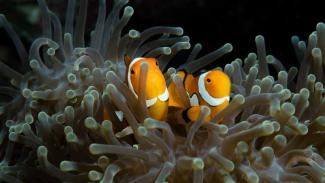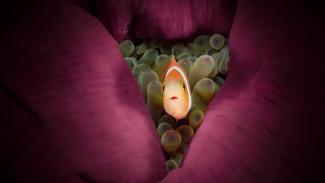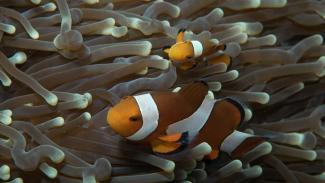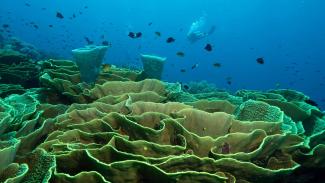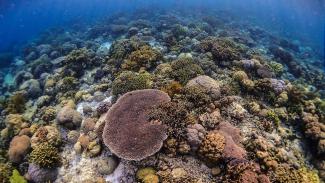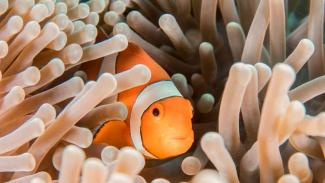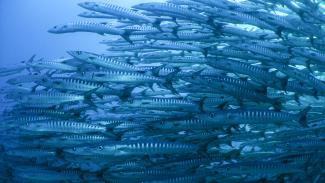Clownfish are great subjects for underwater photographers.
Not only are they colourful and full of character, but they are also one of the most iconic and well recognised fish in the sea. A good Clownfish photo nevers fails to provoke a reaction from your audience.
They are also a very tricky subject to photograph, leaving many budding photographers frustrated.
So what can you do to get a great shot?
Here's how....
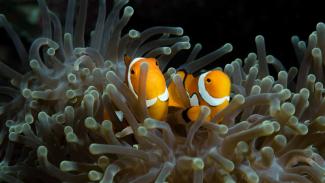
Did You Know?
Freezing the action
The first problem with Clownfish is their speed of movement. They are quick and skittish, rarely staying still long enough to compose a good shot.
They are also very territorial, frequently darting aggressively towards your lens. We have all had frustrating experiences where every shot is blurred, or the Clownfish is only partly in the frame.
To overcome this, you need to freeze the movement so that it is sharp. If you have a simple compact camera with no manual controls, then the best way to do this is to select your camera's sport scene mode.
Sport mode is designed to capture fast action, so it is perfect for capturing your clownfish as he zips around his anemone. The mode works by selecting a fast shutter speed – the amount of time that the camera's shutter is open – preventing blurry movement.
If you camera has more controls, then you can try taking the shot in 'Shutter Priority' or 'Manual' mode – usually represented by 'Tv' and 'M' on your mode dial – and selecting a shutter speed of at least 1/500th of a second.
Colour & composition
The downside of using a fast shutter speed is that you will have less light in your shot. To overcome this problem, make sure you get as close as you can to your subject - without touching the reef of course.
The closer you are, the less distance the available light has to travel and the more colours you will have in your photo.
Getting close will also mean that the Clownfish, although very small, takes up a good proportion of your frame & does not just appear as a small orange dot in the background.
Another little trick is to pay attention to the host anemone. In a large anemone, the Clownfish can cover lots of ground, limiting your chances of getting a good shot. In a small anemone, his movements will be limited, giving you a better chance of success.
The final piece of the jigsaw is to watch the Clownfish patiently. Understanding fish behaviour is crucial to good underwater photography, so if you follow its movements for a couple of minutes, you may start to see a rhythm where before you saw only frantic, random movements. You can then use this to your advantage to capture a sharp, well-composed and well-lit shot of a Clownfish.
You may not get it right first time, but with a little bit of patience & a few attempts, you should have a shot to remember.
TOP TIPS
Select a fast shutter speed, or sports mode if you cannot select a shutter speed
Get close to your subject and wait patiently
Choose a smaller anemone if possible
Follow the behaviour of the Clownfish closely
You might also enjoy...
Kimbe Bay
Kimbe Bay is on the island of New Britain, a large island running east to west that separates the Solomon Sea to the south from the Bismark Sea to the north.
The area is known for its stunning coral formations and boasts a huge diversity of marine life, from Dolphins, Sharks and Whales to endless tiny invertebrates.
Underwater housing care
Jakob Owens
Buying all the kit to allow you to take photos underwater is not cheap, so you need to make your equipment lasts the test of time.
One of the major and most vital expenses is your underwater housing. Housings are often fragile and can require a lot of care and attention though. So what should you be doing to look after your housing and to make sure it has a happy and healthy life?
Wakatobi
The islands that make up the Wakatobi chain have some of the world’s best diving with atolls, walls, fringing reefs, sea mounts & a barrier reef contributing to the almost limitless diving opportunities.
The national park comprises of four main islands, Wangi Wangi, Kaledupa, Tomea & Binongki (thus the name WaKaToBi) the reach out from the south-eastern tip of Sulawesi.
Bunaken National Park
Situated off the northern coast of Sulawesi, Bunaken provides a variety of excellent dive sites.
A marine park since 1991, it is one of Indonesia's most famous diving spots.
The nutrient-rich waters result in vibrant and healthy reef eco-systems, with a high level of bio-diversity and superb marine life sightings.
Sipadan & Mabul Island
Sipadan is Malaysia’s most famous diving spot. Nearby, Mabul Island offers more excellent diving for smaller marine life, and a good choice of dive resorts.
These nutrient-rich waters attract huge numbers of Turtles, while the area is also home to large number of White-tip Reef Sharks, Bumphead Parrotfish, Trevally and Barracuda.
Underwater photography etiquette
Tara North


